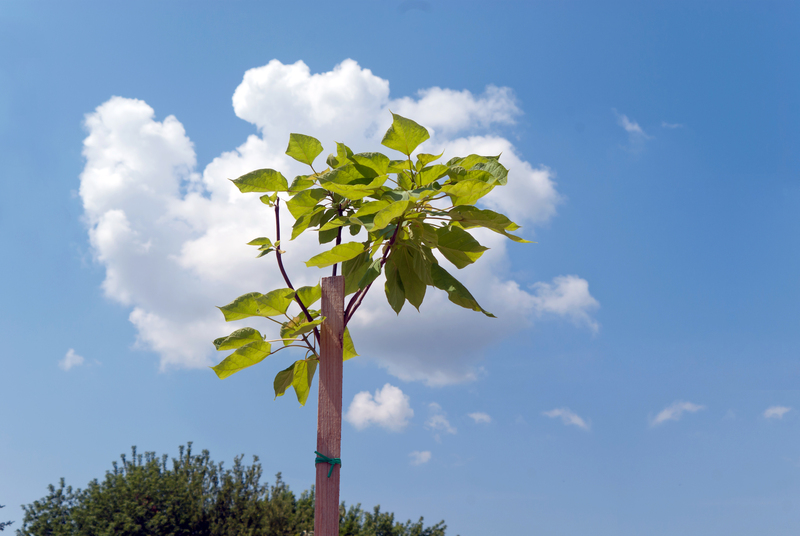Using Your Garden to Make a Positive Climate Impact
Posted on 13/06/2025
Using Your Garden to Make a Positive Climate Impact
Gardening is more than just a relaxing hobby or a way to beautify your outdoor space. Did you know your garden can play a significant role in combating climate change? Across the globe, homeowners and community gardeners are transforming their gardens into climate-friendly ecosystems that help reduce carbon emissions, foster biodiversity, and promote sustainability.
If you're passionate about the environment and want to make a real difference, this comprehensive guide will show you how using your garden to make a positive climate impact can be rewarding, effective, and even inspirational for your neighborhood.
Why Gardening for Climate Matters
Climate change is arguably the most urgent challenge of our time. Human activities -- notably burning fossil fuels and intensive agriculture -- release greenhouse gases that trap heat in our atmosphere. Your garden has the potential to counteract these impacts by acting as a carbon sink, supporting pollinators, and fostering ecological balance.
- Plants sequester carbon dioxide through photosynthesis, storing it in their leaves, stems, and roots.
- Healthy gardens promote diverse soil life, which enhances carbon storage below ground.
- Green spaces cool urban areas, reducing the urban heat island effect.
- Native habitats support biodiversity, making urban environments more resilient.
Every garden, no matter the size, can help tackle climate change when managed with sustainability in mind. Let's explore the practical steps and strategies you can start applying today.

Sustainable Gardening: Core Principles for Positive Climate Impact
To maximize your garden's ability to fight climate change, focus on these core sustainable gardening practices:
1. Carbon Sequestration Through Plant Selection
- Grow perennial plants and trees: They store more carbon over their lifetime than annuals, providing lasting benefits to the climate.
- Integrate shrubs, vines, and ground covers into your garden to maximize green coverage and carbon uptake.
- Focus on native species, which are adapted to your local climate and require less maintenance and water.
2. Soil Health and Regenerative Practices
- Reduce tilling: Tilling disrupts soil structure, releasing stored carbon. Opt for no-till or low-till methods.
- Apply organic mulch and compost to protect soil, enrich nutrients, and lock in carbon.
- Plant cover crops to prevent erosion, enhance soil fertility, and increase carbon storage.
3. Water-Wise Gardening
- Use drip irrigation: This minimizes water waste and reduces runoff, a crucial step in adapting gardens to changing climates.
- Collect rainwater in barrels to water plants without tapping into municipal supplies.
- Group plants by water need to ensure efficiency and resilience in your landscape.
4. Organic and Chemical-Free Gardening
- Avoid synthetic fertilizers and pesticides: These products are energy intensive to produce and can harm beneficial soil organisms.
- Practice companion planting and integrated pest management (IPM) to naturally reduce pest populations.
5. Supporting Pollinators and Biodiversity
- Provide diverse plant habitats, including flowering plants, shrubs, and trees for bees, butterflies, and birds.
- Leave some wild areas or create a "mini-meadow" to foster beneficial insects and wildlife.
- Install nesting sites and water sources for pollinators and songbirds.
Designing a Climate-Positive Garden
Transforming your garden into a climate-positive landscape starts with thoughtful design and plant selection. Here's how you can create an outdoor space that not only looks stunning but actively supports the planet.
Choose Climate-Resilient Plants
- Opt for native and drought-tolerant species that thrive in your local conditions, reducing the need for irrigation and chemicals.
- Include evergreens, trees, and shrubs to provide year-round cover and carbon storage.
Layered Planting
- Establish canopy trees, understory shrubs, perennials, and ground covers to create layers that mimic natural forests.
- Layering not only maximizes carbon sequestration but offers crucial habitat for wildlife.
Edible Gardening for Climate Action
- Grow vegetables, fruits, and herbs at home to reduce the carbon footprint associated with transporting and packaging store-bought produce.
- Utilize vertical gardening and intensive planting methods to maximize food production in small spaces.
Lawns: Rethink and Replace
- Traditional turf lawns consume high amounts of water, fertilizer, and energy. Consider replacing or reducing your lawn with pollinator-friendly meadows, native groundcovers, or edible landscapes.
- No-mow zones provide shelter for insects and save carbon emissions from mowing equipment.
Hardscaping with Sustainability in Mind
- Use permeable materials like gravel, stone, or permeable pavers to reduce runoff and boost groundwater recharge.
- Repurpose or reuse materials, such as reclaimed wood or salvaged bricks, to lower your garden's embodied carbon.
Gardening Techniques to Maximize Climate Benefits
With your garden designed for positive climate impact, it's time to focus on practical techniques:
Composting
- Compost kitchen scraps, leaves, and yard waste to create nutrient-rich organic matter. Compost locks carbon into the soil and reduces methane emissions from landfills.
- Use finished compost as mulch or soil amendment for healthier, more fertile garden beds.
Mulching
- Layer organic mulch over soil surfaces to reduce evaporation, moderate temperatures, suppress weeds, and build soil organic matter.
- Wood chips, shredded leaves, and straw are excellent, climate-positive mulching materials.
No-Dig Gardening
- Minimize soil disturbance to protect mycorrhizal fungi and soil carbon stores.
- Simply add compost and new planting layers on top of existing beds for rich, layered soils full of life.
Seed Saving and Heirloom Varieties
- Collect seeds from your healthiest, most resilient plants to grow again, reducing dependence on commercial seed production.
- Share saved seeds with your community to support local food security and biodiversity.
Natural Pest and Disease Management
- Encourage beneficial insects like ladybugs and bees by avoiding pesticides and planting a diversity of species.
- Rotate crops, interplant, and use companion planting to keep pest populations in check.
Reducing Your Garden's Carbon Footprint
A truly positive climate impact garden not only stores carbon and offers habitat but also operates with low emissions at every step.
Smart Tool Choices
- Avoid gas-powered lawn mowers and trimmers. Choose manual, electric, or battery-powered tools for a quieter, cleaner garden experience.
Source Sustainably
- Purchase plants and materials from local nurseries to reduce transportation emissions.
- Recycle and repurpose old containers, bricks, or building materials instead of buying new.
Eco-Friendly Inputs
- Make your own compost and liquid fertilizers from organic materials instead of relying on manufactured products.
- Skip peat moss-based soil mixes; peat harvesting destroys critical carbon sequestering peat bogs.
Water Conservation
- Use drip irrigation and mulch to maximize moisture retention.
- Install a rain barrel system to capture rainwater for garden use, reducing your reliance on treated water.
Encouraging Wildlife: Gardens as Biodiversity Havens
A garden that supports climate impact also encourages wildlife and pollinators. Here's why and how:
- Wildlife gardens provide habitats for beneficial insects, birds, reptiles, and mammals that maintain ecological balance.
- Increase the diversity of flowering plants to supply nectar across the growing season.
- Leave some plant debris, seed heads, or brush piles for overwintering insects and small animals.
- Install birdhouses, bee hotels, and bat boxes for additional shelter opportunities.
Encouraging native wildlife in your landscape builds resilience, enhances soil health, and supports natural pest control mechanisms, all of which are essential for a garden that makes a lasting climate difference.
Community Gardens and Urban Green Spaces: Scaling Up Climate Impact
The more people who embrace climate-friendly gardening, the greater the collective benefit. Community gardens and urban green spaces offer unique opportunities:
- Increase vegetation and tree cover to lower city temperatures, absorb carbon dioxide, and reduce stormwater runoff.
- Enable food production in underserved neighborhoods, cutting transport-related emissions and promoting health.
- Educate and inspire neighbors, schools, and local organizations to live more sustainably.
Join or start a local gardening initiative and organize workshops on sustainable gardening, composting, or biodiversity to extend your impact beyond your backyard.
Measuring and Monitoring Your Garden's Climate Impact
You can tangibly assess how much your gardening efforts are helping the planet. Several online calculators and apps estimate:
- How much carbon your garden sequesters
- How much water you save through conservation techniques
- Biodiversity levels based on plant and wildlife species observed
Keep a simple garden journal, snap photos, or join citizen science platforms to track changes and share results with your community. Measuring progress encourages you to deepen your climate-friendly gardening practices year after year.
Overcoming Barriers: Making Eco-Gardening Work for Everyone
Even if you have a small plot or limited time, you can make a meaningful positive climate impact with your garden.
- Start small: Even a container garden on your balcony can help absorb carbon and support pollinators.
- Swap seeds and cuttings with neighbors to increase diversity for free.
- Educate friends and family about the climate benefits of gardening.
Every positive step counts. The more people who garden with the climate in mind, the bigger our collective contribution to a healthier planet.

Inspiring Climate Impact: The Ripple Effect of Eco-Conscious Gardening
Transforming your garden is about much more than sustainability -- it's about being part of a movement that safeguards our climate and natural world for generations yet to come. When your garden flourishes as a haven for wildlife, a storehouse for carbon, and a source of healthy homegrown food, you demonstrate what's possible and inspire others to follow your lead.
- Share produce, seeds, and knowledge with your community.
- Document your journey on social media or local forums to spread climate gardening awareness.
Using your garden to make a positive climate impact is easier, more rewarding, and more urgent than ever. Whether you're tending a flowerbed, backyard, community plot, or even a window box, you are part of the solution. Your daily gardening choices can help heal the planet -- one plant, one patch of soil, one seed at a time.
Conclusion: Planting Seeds for a Better Climate Future
By making thoughtful choices in design, plant selection, and garden management, you transform your outdoor space into a force for positive climate action. Embrace sustainable gardening methods and watch as your garden sequesters carbon, hosts biodiversity, and inspires others in your community. The solutions to the climate crisis start at home -- and, with every root you plant, you're investing in a safer, greener future.
Let your garden grow not just for beauty, but for the climate -- and together, we'll cultivate a planet worth inheriting.

